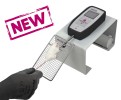Authors
M. Andres-Mach, A. Zadrożniak, A. Haratym-Maj, M. Florek-Luszczki, G. Raszewski et al.
Lab
Institute of Rural Health, Lublin, Poland
Journal
Neurology and Preclinical Neurological Studies
Abstract
The aim of this study was to characterize the interaction between 1-methyl-1,2,3,4-tetrahydroisoquinoline (1-MeTHIQ—an endogenous parkinsonism-preventing substance) and various antiepileptic drugs [AEDs: clonazepam (CZP), ethosuximide (ETS), gabapentin (GBP), levetiracetam (LEV), tiagabine (TGB) and vigabatrin (VGB)] in the mouse maximal electroshock (MES)-induced seizure model. Results indicate that 1-MeTHIQ in combination with CZP (at the fixed ratios of 50:1 and 25:1), ETS (1:10) and GBP (1:1, 1:2, 1:5 and 1:10) exerted supra-additive (synergistic) interactions in the mouse MES model. In contrast, 1-MeTHIQ in combination with CZP (200:1 and 100:1), ETS (1:1, 1:2 and 1:5), LEV and VGB (1:1, 1:2, 1:5 and 1:10), and TGB (200:1, 100:1, 50:1 and 25:1) produced additive interaction in the mouse MES model. Total brain AED concentrations were unaffected by 1-MeTHIQ, and inversely, CZP, ETS and GBP had no impact on total brain concentrations of 1-MeTHIQ, indicating pharmacodynamic nature of synergistic interactions between 1-MeTHIQ and the tested AEDs in the mouse MES model. In conclusion, the supra-additive interactions of 1-MeTHIQ with CZP (at the fixed ratios of 50:1 and 25:1), ETS (1:10) and GBP (1:1, 1:2, 1:5 and 1:10) in the mouse MES model appear to be particularly favorable combinations from a clinical viewpoint. The additive combinations of 1-MeTHIQ with CZP (100:1, 50:1), ETS (1:1, 1:2 and 1:5), LEV and VGB (1:1, 1:2, 1:5, and 1:10), and TGB (200:1, 100:1, 50:1 and 25:1) seem to be neutral and worthy of consideration in further clinical practice.
BIOSEB Instruments Used:
Grip strength test (BIO-GS3)

 Pain - Thermal Allodynia / Hyperalgesia
Pain - Thermal Allodynia / Hyperalgesia Pain - Spontaneous Pain - Postural Deficit
Pain - Spontaneous Pain - Postural Deficit Pain - Mechanical Allodynia / Hyperalgesia
Pain - Mechanical Allodynia / Hyperalgesia Learning/Memory - Attention - Addiction
Learning/Memory - Attention - Addiction Physiology & Respiratory Research
Physiology & Respiratory Research
 Pain
Pain Central Nervous System (CNS)
Central Nervous System (CNS) Neurodegeneration
Neurodegeneration Sensory system
Sensory system Motor control
Motor control Mood Disorders
Mood Disorders Other disorders
Other disorders Muscular system
Muscular system Joints
Joints Metabolism
Metabolism Cross-disciplinary subjects
Cross-disciplinary subjects CONFERENCES & MEETINGS
CONFERENCES & MEETINGS 